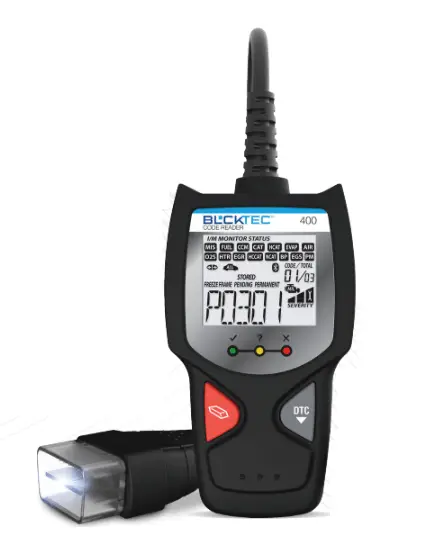BLCKTEC 420 OBD2 Code Reader and Car Diagnostic Tool User Manual
With a wide range of diagnostic capabilities, the BLCKTEC 420 OBD2 Code Reader and Car Diagnostic Tool is a vital tool for both automotive professionals and enthusiasts. Diagnostic trouble codes (DTCs) for engines and other vehicle systems may be quickly and accurately read with this easy-to-use equipment that connects to the OBD2 port of most cars. It is an indispensable tool for locating and fixing automotive problems since it allows for real-time data monitoring, freeze-frame data recording, and the determination of the I/M readiness state for emissions testing. The BLCKTEC 420 is perfect for basic maintenance, troubleshooting, and making sure your car stays in top operational condition because of its small size and simple interface.

How to Use BLCKTEC 420 OBD2
Using the BLCKTEC 420 OBD2 Code Reader and Car Diagnostic Tool is generally straightforward, and involves a series of simple steps:
- Locate the OBD2 Port: First, find the OBD2 port in your vehicle. It’s usually located under the dashboard, near the steering wheel, but its position can vary depending on the vehicle.
- Plug in the Device: Once you locate the OBD2 port, plug the BLCKTEC 420 into it. Make sure the connection is secure.
- Start Your Vehicle: Turn on the engine of your vehicle. The BLCKTEC 420 requires the engine to be running to operate correctly.
- Initialize the Device: After starting your vehicle, wait for the BLCKTEC 420 to initialize. It should power on and may run a self-check process.
- Navigate the Menu: Use the buttons on the device to navigate through the menu. The BLCKTEC 420 typically has a simple, user-friendly interface with options to read codes, view live data, check I/M readiness, etc.
- Read Diagnostic Trouble Codes (DTCs): If the check engine light is on, navigate to the ‘Read Codes’ section to display any stored codes. These codes help identify any issues or faults within the vehicle.
- Clear Codes: After fixing the issue that caused the DTCs, you can use the device to clear these codes. This will typically turn off the check engine light.
- View Live Data: The BLCKTEC 420 can display live data streaming from various sensors in the vehicle. This feature is useful for real-time diagnosis and monitoring vehicle performance.
- Check I/M Readiness: This function allows you to check if your vehicle is ready for an emissions test, indicating if the various emissions-related systems have been checked and passed by the vehicle’s onboard computer.
- Turn Off the Device: After you finish the diagnosis or data reading, turn off your vehicle’s engine and then unplug the BLCKTEC 420 from the OBD2 port.
- Refer to the Manual for Specific Features: Different models may have unique features or menu structures. Always refer to the user manual for specific instructions related to your device.
- Seek Professional Help if Needed: If you are unsure about interpreting the diagnostic codes or about fixing the issues, consult a professional mechanic.
Remember, regular use of an OBD2 scanner like the BLCKTEC 420 can help you keep track of your vehicle’s health and catch potential issues early, leading to easier and less costly maintenance.
FAQs Of BLCKTEC 420
A: Locate the OBD2 port in your vehicle, usually found under the dashboard, and plug the device into this port.
A: It is compatible with most OBD2-compliant vehicles manufactured from 1996 onwards.
A: Yes, it can clear the check engine light once you have read and addressed the diagnostic trouble codes (DTCs).
A: No, it is powered directly through the OBD2 connection with your vehicle.
A: Typically, updates are not required for basic OBD2 code readers. If updates are available, refer to the user manual for specific instructions.
A: This depends on the model and make of the vehicle. Check the product specifications for details on these features.
A: The user manual often includes common codes, or you can search the codes online for detailed explanations.
A: Yes, it can check the I/M readiness status, which is part of emission testing.
A: It is not recommended as it may drain the vehicle’s battery over time.
A: Navigate to the ‘Live Data’ or similar option in the device menu to view real-time data from your vehicle’s sensors.
A: Check the connection to the OBD2 port and ensure that your vehicle’s ignition is on.
A: This depends on the vehicle and the capabilities of the device. Refer to the product specifications for this feature.
A: Use the buttons on the device to scroll through the menu options and select the function you need.
A: Typically, basic OBD2 scanners do not have printout capabilities. Check the user manual for your specific model.
A: Customer support information is usually provided in the user manual or on the manufacturer’s website.


